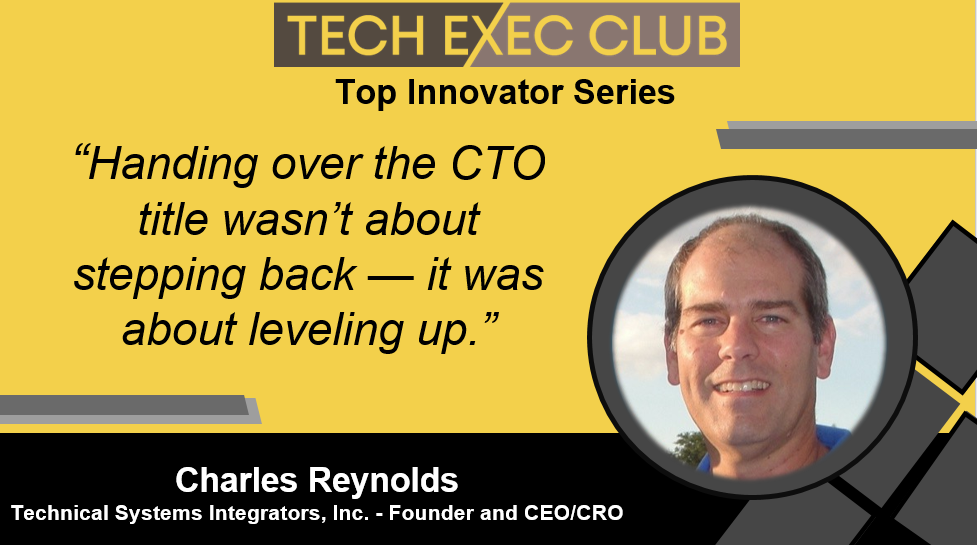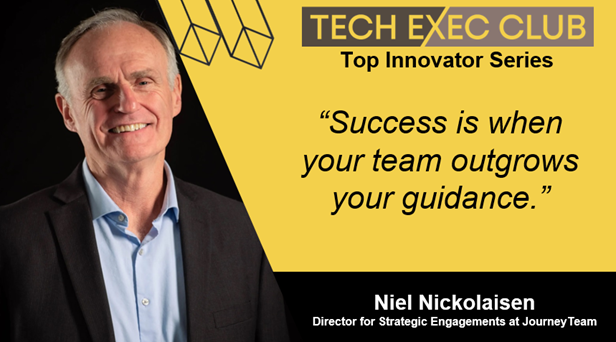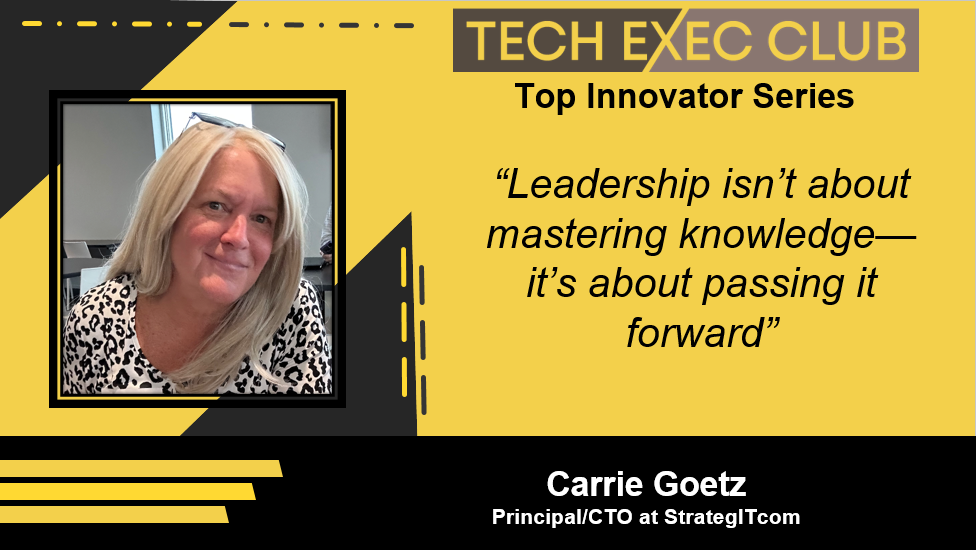Charles Reynolds is a rare breed—a technologist with a CEO’s vision, a strategist with a builder’s hand, and a leader who knows when to let go.
As the founder, CEO, and (until recently) CTO of Technical Systems Integrators, Charles has led his company through multiple industry pivots, near-collapse, bold rebuilds, and cutting-edge innovations—all without ever growing a bloated team. His secret to success? Doing more with fewer, more intelligent people. Fewer than a dozen staff, he says, can outperform teams five times their size—if you hire the right ones.
In a refreshingly candid conversation on the Top Innovator Series hosted by Josef Martens, Charles opens up about the lessons learned from bad hires, business betrayals, and the subtle art of handing over the title of CTO without losing your soul. From building automation solutions with massive ROI to embracing AI and preparing for quantum computing, Charles always looks out the window, watching the next thing fly by.
But for all his technical brilliance, what stands out most is his grounded wisdom. “Don’t hire until everyone’s overstretched. Hire from your customer base. And never, ever get a partner if you can help it.”
This is the story of how one founder continually reinvents himself, his team, and the very meaning of leadership — without ever compromising the one thing that matters most: results.
Reinvention Through Relentless Learning
Some leaders build a company and ride the same wave for decades. Charles Reynolds isn’t one of them. After spending 20 years in one industry, he didn’t just pivot — he completely rebuilt his business in a new space. That decision wasn’t driven by desperation; it was fueled by curiosity.
Charles describes himself as a “consummate learner,” someone always chasing what’s flying past his window. While some might call this distraction, he sees it as strategic agility. “Things move so fast in technology,” he says. ”You have to constantly learn—about your business, your people, your tools.”
He lives that philosophy. Whether using AI to rewrite documentation, exploring new tools to automate processes, or preparing his company for the dawn of quantum computing, Charles isn’t just watching from the sidelines — he’s early to the game. He’s also an unapologetic tech enthusiast, updating his hardware every 18 months and constantly testing new platforms to accelerate his team’s work.
And it’s not just about tools. It’s about discipline—reading voraciously, experimenting constantly, and mentoring his team to do the same. For Charles, reinvention isn’t a crisis—it’s a habit.
Why Small, Elite Teams Outperform Big Ones
In a world obsessed with headcount, Charles Reynolds believes less is more — much more.
“People look at us and think we’re 50 to 100 people,” he says with a grin. “We’re 10.” His team regularly delivers multi-million-dollar ROI for enterprise clients, outpacing competitors with five times the staff. The secret? Tiger teams — small, high-impact squads composed only of A-players.
Charles learned this the hard way. In the early days, he hired junior people and tried to train them. It was expensive, slow, and unpredictable. “You don’t know if they’ll get it for nine months,” he says. Now, he hires only when the team is stretched — and only hires proven experts.
His best hires come from his customers. These people have already used his tools for years, understand the ecosystem, and have proven communication skills. “They don’t call us unless it’s a real problem,” he says. “We know they’re good.”
AI has only strengthened his conviction. “With AI, it’s about asking the right questions. That takes experience. That takes SMEs.”
Charles’s advice? Skip the bloated org chart. Find 10 brilliant people and let them move faster than your competitor’s 100.
Learning from Hiring Mistakes — and Never Repeating Them
One of Charles Reynolds’ most painful leadership lessons came from someone with access to the books—literally. “We hired a crooked bookkeeper,” he says. “She stole a lot of money from us, and it happened during 9/11.”
For years, the team had trusted the numbers. Everyone seemed happy, and the revenue looked strong. But underneath the surface, money was leaking—slowly, invisibly. By the time they discovered the fraud, it was too late to recover most of it. The judge, fortunately, saw the damage and issued a harsh sentence.
That experience taught Charles never to take finances at face value and to double-check every process. “We were trusting engineers,” he says. “Now, we automate everything. We’re on top of it daily.”
It also changed how he hires — forever.
He no longer hires off the street. Every new employee must come recommended, preferably from a client, vendor, or trusted network. He looks beyond résumés. “We want to know them. We want to have seen their work.” And once they’re in, there’s a three-month probation. “It’s not just about testing them—it’s about letting them test us.”
Burned once. Never again.
Letting Go of the CTO Role (Without Letting Go of Control)
Handing over a title you’ve worn for decades is never easy. But Charles Reynolds knew it was time.
At the start of 2024, Charles officially handed over the CTO role to a long-time team member who had been with him for nearly 25 years. It was a symbolic move, but not just that. It marked a genuine transition of power and responsibility.
“He’s the perfectionist,” Charles says. “He’s been amazing for us. But he’s also mild-mannered and risk-averse. This new role will stretch him.”
The handoff isn’t happening overnight. Charles built a nine-month co-leadership model in which he remains involved but not in control. “He’s running the big proof-of-value engagements now. I’m stepping back and coaching.”
This gradual shift lets the new CTO find his voice while leveraging Charles’s decades of experience. It also allows Charles to move into a more focused chief revenue officer role — building partnerships, growing accounts, and preparing the company for the next phase.
The hardest part? Letting go of the tech. “I love the engineering. But it’s time. These young minds are drinking from a firehose — and thriving.”
The Hidden Cost of the Wrong Partner
In business, picking the wrong partner can be as costly as hiring the wrong employee — maybe more so.
Charles learned that early in his journey. “My first partner helped get us started,” he says. “But then he just wanted to be chairman of the board — not a worker bee.”
At Technical Systems Integrators, that wasn’t going to fly. “There are no chiefs here. We’re all Indians. We all work.” When one person stops pulling their weight, it slows everyone down — especially in a small, high-performing team.
Eventually, Charles parted ways with his partner. It was a clean break but a revealing one. His takeaway: only take on a partner if there’s no other option.
The same applies to cultural fit. Whether it’s a co-founder or a team member, Charles looks for alignment in ethics, curiosity, and ownership. Titles matter less than hustle.
Today, he runs the business with a lean leadership team and a strong internal culture. When it comes to advice for aspiring founders, he’s clear: “If you can do it solo, do it solo. Then build the team you need.”
Charles Reynolds has distilled decades of entrepreneurial experience into clear, actionable leadership wisdom, including reinventions, painful lessons, and bold decisions. Here’s what tech leaders, founders, and aspiring innovators can take away and put into action today:
1. Invest in Learning — Relentlessly: Don’t stop learning after you “make it.” Stay curious about everything in your field (and outside of it). Make continuous learning a daily habit. Read, test tools, listen to industry podcasts, and stay ahead of emerging tech. Adopt new tech quickly. Use tools like ChatGPT, bone-conduction headsets, and tablets if they make you faster. Treat your tech like a performance multiplier.
2. Hire Slowly—and Only Hire the Best: Don’t hire just to fill a seat. Wait until your team is overstretched, then hire precisely for the need. Only bring on proven talent. Hire from your customer or vendor base—people who know your tools and culture already. Avoid mediocre talent. A single A+ player can do the work of three B-level hires.
3. Build Small, Elite “Tiger Teams”: Scale impact, not headcount. Focus on high-performance teams over high-volume hiring. Use AI and automation to amplify smaller teams. Invest in tools that make your best people even more effective. Stay lean. People should think you’re a company of 100 — when you’re only 10.
4. Let Go to Grow: Plan your succession if you’re a founder. Don’t wait until burnout or decline. Start training your replacement while you’re still strong. Design a transition plan. Charles recommends a 6–9 month co-leadership window to ease into role changes. Get comfortable not being the most competent tech person in the room. Let the next generation lead — and support them from behind the scenes.
5. Trust… but Verify: Put systems in place. After being burned by a bookkeeper who embezzled funds, Charles uses automation and rigorous oversight to stay in control. Don’t assume things are fine just because revenue is up. Dig into the details. Use tools and dashboards that provide visibility into your numbers — every day.
6. Choose Partners Carefully—Or Not At All: Avoid unnecessary co-founders. Unless your partner is essential, go solo and build the leadership team from scratch. Evaluate values, not just skills. Ask: Will this person work as hard as me? Do they take ownership? Will they still grind when it’s not fun? If it’s not working, exit early. Don’t drag out relationships that slow you down.
7. Ask Better Questions (Especially with AI): Prompt engineering is leadership. With tools like AI, better questions get better results. Train your team to ask — and think — better. The quality of output is directly tied to the quality of inquiry. Invest in SMEs who know what questions to ask. AI is only as powerful as the experience behind it.
Charles Reynolds may have officially handed over the CTO title, but make no mistake — he’s still at the helm of innovation. His story is one of reinvention, resilience, and radical focus: building high-ROI technology with small, elite teams, staying ahead of disruption through constant learning, and knowing when to let go — even when it’s hard.
As the founder and CEO of Technical Systems Integrators, Charles has turned lean leadership into a competitive advantage. He’s proven that technical excellence doesn’t require large organizational charts and that the right team of 10 can outperform companies five times their size.
But what sets Charles apart isn’t just his strategic thinking and willingness to evolve. Whether onboarding AI, empowering the next CTO, or redefining what leadership looks like at every stage, Charles shows that true innovation starts not with code but with courage. For any leader wondering how to scale impact, strengthen teams, or step into their next chapter — Charles Reynolds is a blueprint worth studying.
Want to hear Charles Reynolds’s insights firsthand? Watch the full, live podcast interview [click here]





